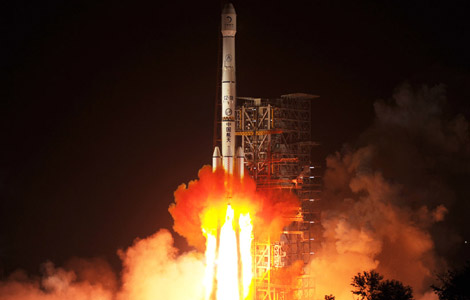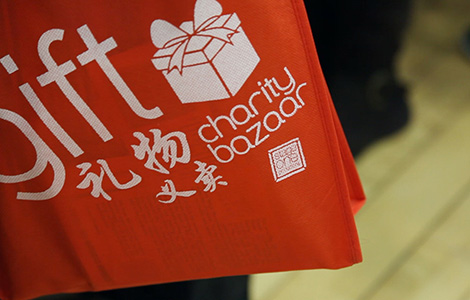Economic rebound not likely: group
Updated: 2013-12-02 11:23
By Michael Barris in New York (China Daily USA)
|
||||||||
China's economic slowdown is reaching bottom, but prospects for a rebound next year look dim amid an expected drop in the national growth rate, a US manufacturing industry group said.
The Manufacturers Alliance for Productivity and Innovation (MAPI) said the outlook for China will remain "murky" as GDP drops to 7.1 percent in 2014 from 7.3 percent this year amid "an extended period of slower growth".
"While recent Chinese data have suggested a bottoming of the sharp slowdown in Asia's largest economy, there is no sense of a definitive rebound on the short-term horizon," Virginia-based MAPI said in its Asian manufacturing outlook.
The report comes three weeks after China's leaders pledged to implement sweeping economic and social reforms aimed at putting the world's second-largest economy on a more stable footing.
MAPI's forecast is less rosy than the view from the Organization for Economic Cooperation and Development, which last week forecast Chinese GDP growth of 8.2 percent in 2014, up from an expected 7.7 percent this year, driven by stronger domestic demand. MAPI's view also is more pessimistic than the consensus forecast of economists surveyed by Reuters, which sees growth slowing to 7.4 percent in 2014 from an expected 7.6 percent this year. China's government has set a 2013 growth target of 7.5 percent.
MAPI said China's economic growth became more stable in the third quarter mainly due to "a gradual recovery in exports and public investment". China's growth rate had been sagging earlier this year amid the government's effort to shift the country's economic model away from exports and investment and toward private consumption.
China's economic slowdown is expected to drag on as the country confronts a "sluggish world economy", according to the MAPI report.
Other factors seen as crimping hopes for a quick economic rebound, according to MAPI, are "increasingly difficult demographic challenges affecting labor supply" - a reference to China's effort to move a quarter of a billion rural residents into newly built cities by 2025 - and challenges in rebalancing the economy toward personal consumption.
Industrial production is expected to slow to 9 percent in 2014 from 9.2 percent this year, the report said.
MAPI economist Ernie Preeg told China Daily in early November that third-quarter data showing production in China growing faster than GDP shows the country's "grand strategy of shifting resources to personal consumption isn't happening".
Personal consumption in China represented 35 percent of GDP in the quarter, Preeg said. To boost personal consumption to 40 or 45 percent of GDP, "you have to have annual growth of 15 to 20 percent a year", the economist said.
China's cooling economy has begun to hurt the financial results of Western companies with large stakes in the country. In the third quarter, companies that reported trouble in their Chinese operations included Microsoft Corp, the Seattle, Washington-based software giant; Danaher Corp, the Washington-based maker of water filters, printing equipment and medical devices; and IBM Corp, the Armonk, New York, IT provider.
The US-China Business Council said in its annual China business survey in October that fewer companies this year have reported profit margins in China that were superior to those at global operations, and fewer companies have reported double-digit revenue increases.
Despite its slipping economy, China still attracts foreign investment at a rate that would be envied by other nations. The country attracted $8.38 billion of foreign direct investment in August, up 0.62 percent from a year earlier, according to the Ministry of Commerce. In the first eight months of this year, China attracted $79.8 billion of FDI, up 6.4 percent from the same period in 2012, but below the economy's growth rate.
Asia-wide, MAPI gave a mixed outlook, projecting a modest rise in GDP growth in developing Asia to 6.5 percent in 2014 from 6.3 percent in 2013 - weaker than the 6.9 percent growth seen in 2012.
The trade group said the "positive regional impact of stimulus efforts in key countries" was "somewhat negated by unusually volatile currency and financial market activity".
Investment growth in China remained "relatively stable" in the first three quarters of 2013, according to the MAPI report, as the "acceleration of public investment in transportation and affordable housing at least partially offset weak investment in manufacturing and the private property market".
michaelbarris@chinadailyusa.com
(China Daily USA 12/02/2013 page2)
- Experts discussion: Where now for the China economy?
- China economy stabilizing: NBS
- China economy has potential to sustain fast growth
- World wants to see a healthy China economy
- OECD sees China growth accelerating in 2014
- US global tech firm targets China growth
- World Bank sees 2013 China growth of 7.7 percent
Most Viewed
Editor's Picks

|

|

|

|

|

|
Today's Top News
Economic rebound not likely: group
Stocks dive after IPO reforms announced
Cheap luxury, startup required
 Drama Rhinoceros In Love staged in New York
Drama Rhinoceros In Love staged in New York
Washington's panda named Bao Bao
Candid exchange key to Biden's visit
At least 4 dead in NYC commuter train derailment
China's new billionaires may have a lot to learn
US Weekly

|

|













